Best of Rajasthan

from £1200
from £1050 Per Person
12 Nights / 13 Days
This combination of enchanting destinations however, displays the richness of India`s history, heritage, rural and culture very beautifully in shortest time possible with value of money.
Inclusions:
- Overview
- Itinerary
- Hotels
- Exclusions
- Extras
Overview
Travel throughout beautiful cultural India, city full with diversity with different taste and explore some world famous attraction including Majestic Rajasthan with cultural, spiritual part of India. This tour includes all aspects of Indian life and represents past and present cultural, rural and beautiful Royal India.
This combination of enchanting destinations however, displays the richness of India’s history, heritage, rural and culture very beautifully in shortest time possible with value of money.
Inclusions
- Return flight from London to Delhi
- Accommodation in hotel as per chosen category
- Meal as mentioned
- All transfer and sightseeing as per itinerary
- Guide at Monuments
- Rikshaw ride at Delhi
- Elephant ride at Jaipur
- Tonga ride at Agra
- Boat ride at Udaipur
- Bird sanctuary visit by Rikshaw at Bharatpur
- Dinner and cocktail at Raisar sand dunes, Bikaner
- Camel ride at Raisar sand dunes, Bikaner
Village Safari by Jugard
Itinerary
Day 1
Fly from London to Delhi.
Day 2
Arr Delhi
On arrival at the airport, meet your representative and transfer to hotel. Afternoon proceed for sightseeing of “New Delhi” which is also known as Lutyens Delhi, taking after the name of a British architect who was largely responsible in designing India Gate, Presidential House, Secretariat, Parliament House and many other buildings in that area. Visit the recent jewel in the crown "Lotus Temple" and then drive on to see the tallest tower in Delhi, known as Qutub Minar, which declared the arrival and rise of Islam in India. Visit Qutub minar – the great monument of Delhi was built by Qutubuddin Aibek. Overnight at Hotel.
Meal: No Meal
Day 3
Delhi–Mandawa
Have a leisurely breakfast and proceed to Mandawa. On arrival, check into hotel. Later visit Mandawa: a small town in the heart of Shekhawati region. The place is known not only for its havelis (mansions) but also for its Fort Palace. The structure of the palace reminds of the cultural and social importance of this region in the past. Of the havelis, the most important are the Chokhani, Ladia and Gulab Rai Ladia Haveli. Another haveli, the Bansidhar Newatia Haveli is known for its curious paintings. There is a painting of a boy holding a telephone and a European woman in a car driven by a chauffeur. The Gulab Rai Ladia Haveli is famous for its erotic images, now mostly defaced. Overnight at Hotel.
Meal: Breakfast
Day 4
Mandawa–Bikaner
After leisurely breakfast, proceed for Bikaner. On arrival check into the hotel. Later explore Bikaner and experience the royal legacy of the bygone era. Bikaner popularly called the camel country; the city is renowned for the best riding camels in the world. The ship of the desert is an inseparable part of life here - Be it pulling heavy carts, transporting grains or working on wells. Bikaner stands on a slightly raised ground and is circumscribed by a seven km long embattled wall with five gates. The magnificent forts and palaces created with delicacy in reddish-pink, sandstone, bear testimony to its historical and architectural legacy. Bikaner’s history date backs to 1488 AD when a Rathore Prince, Rao Bikaji - a descendant of the founder of Jodhpur (1459 AD) Rao Jodhaji, established his kingdom here. Evening enjoy folk dance and dinner at Raisar sand dunes. Overnight at Hotel.
Meal: Breakfast
Day 5
Bikaner–Jodhpur
After breakfast, drive to Jodhpur, bustling desert city is the second largest city in Rajasthan and has landscape dominated by the massive Mehrangarh Fort topping a sheer rocky ridge. Rao Jodha, a chief of the Rathore clan, founded the city in the year 1459 and it is named after him. It was formerly the seat of a Princely state, also known as Marwar. Upon arrival check in at hotel. Later enjoy guided tour of Jodhpur, visiting the Mehrangarh Fort (Majestic Fort), one of the most impressive and formidable structures anywhere in India. Built by Rao Jodha, this 5km long Fort is on a 125m high hill and has some magnificent palaces with marvellously carved panel’s latticed window. The Fort Museum houses an exquisite collection of palanquins, howdahs (Elephant saddles), royal cradles, miniatures paintings, musical instruments, costumes and furniture. Also visit Jaswant Thada, a cluster of royal cenotaphs in white marble built in the year 1899 AD in memory of Maharaja Jaswant Singh II. Overnight at Hotel.
Meal: Breakfast
Day 6
Jodhpur–Ranakpur–Udaipur
After breakfast drive to Udaipur. Enroute pass lush green valleys, streams and heart capturing views before visiting Ranakpur. Renowned for its Jain temples with intricately carved marble Pillars and Domes, Ranakpur is amongst the five holiest places of the Jain community and exceptional in beauty. Tucked away in a remote valley in the Aravalli ranges, it boasts of one of the largest and most important Jain Temples in the country. It has a four-temple complex which is famous for its peaceful and harmonious surroundings. The temples are believed to have been built in 1439 A.D. The temple rests on 1444 elegantly carved pillars, with no two being identical and the realistic sculptures of celestial nymphs playing the flute in various dance postures at a height of 45 feet are a fascinating sight to see. The two huge bells weighing 108 kgs each, whose sound echoes in the entire complex, add to the temple’s allure. On arrival at Udaipur, check in at hotel. Rest of the evening to enjoy at leisure. Overnight at Hotel.
Meal: Breakfast
Day 7
Udaipur
Have a leisurely breakfast and proceed for guided sightseeing tour of Udaipur. Founded by Maharaja Udai Singh in 1568, Udaipur is situated on the banks of Lake Pichola with lush green hills of the Aravalli surroundings, making it the most romantic city of Rajasthan. A vision in white drenched in beauty, the city is a fascinating blend of sights and sounds the rich cultural, social and natural heritage, aesthetic beauty and ecological richness, preserved through the lakes, serene and opulent hilly ranges, lush green vegetation, pleasant gardens and harmonious built forms present a unique condition of scenic beauty. Visit City Palace, Jagdish Temple, Museum, Jag Mandir- a temple dedicated to Lord Jagdish and Saheliyon-Ki-Bari. We also visit the Bhartiya Lok Kala Mandir which is an Indian folk arts museum and has interesting exhibits that include folks dresses, ornaments, puppets, masks, dolls, folks musical instruments, folk deities and paintings. Enjoy a boat ride on Lake Pichola, an artificial fresh water lake, created in the year 1362 AD, named after the nearby Picholi village. It is one of the several contiguous lakes and developed over the last few centuries in and around the famous Udaipur city. The lakes around Udaipur were primarily created by building dams to meet the drinking water and irrigation needs of the city and its neighbourhood. Two islands, Jag Niwas and Jag Mandir are located within Pichola Lake and have been developed with several palaces to provide views of the lake. Conclude your day with a fantastic cultural show at the Bagore-ki-Haveli where you might even get up and join in the dancing. Overnight at Hotel.
Meal: Breakfast
Day 8
Udaipur–Pushkar
After leisurely breakfast, we will leave early morning and drive to Pushkar, the charming and usually peaceful Hindu pilgrimage centre and home of the only temple in India dedicated to the god of creation Lord Brahma. Upon arrival Pushkar, check in at hotel. Rest of the day at liesure to explore Pushkar. Overnight at Hotel.
Meal: Breakfast
Day 9
Pushkar–Jaipur
After early breakfast, proceed to Jaipur. On arrival Jaipur, check into hotel. On this day enjoy the guided sightseeing tour of the pink city built by Maharaja Jai Singh, the notable astronomer 260 years ago. Here the past comes alive in magnificent forts and palaces, blushed pink, where once lived the Maharajas. Take an excursion to Amber Fort; add a magical touch to the visit by riding on the back of an elephant from the foot of the hill up to the gates of the fortress in the manner of former kings and queens. Within the complex, Ganesh Pol, an imposing gateway painted with images of the elephant-headed god, Ganesh takes pride of the place. Also a part of the complex is the Diwan-I-Aam (Hall of the Public audience) with its spectacular display of pillars. Also visit the Maharaja’’s City Palace, the home of the erstwhile royal family, the Observatory, Hawa Mahal also known as Wind Palace built in 1799 by Maharaja Sawai Pratap Singh and drive past the old part of Jaipur city. This fascinating city with its romantic charm takes you to a feel of royalty and tradition and has plenty of forts and monuments that remind you of the ancient glamour, glory and charm of Rajput rulers. Remaining of the day is free to explore local bazaars, which are known for its embroidered leather shoes, blue pottery, tie and dye scarves and other exotic wares or relax at your hotel. Overnight at Hotel.
Meal: Breakfast
Day 10
Jaipur–Bharatpur
After breakfast, proceed to Bharatpur. Enroute visit beautiful and world’s most haunted place Bhangarh’s castle ruins. The town was established in 1573 (VS 1631) during the rule of Kachwaha Rajput ruler of Jaipur Bhagwant Das as the residence of his second son Madho Singh. The next ruler of Bhangarh was his son Chhatra Singh. Bhangarh is also a pre-historic site. The most remarkable of its buildings are the Hindu Mandir of Gopinath, Shiv (Someshwar), Hanuman, Ganesh, Vishal Devta, Lavina Devi and Keshav Rai. Here Govt. of India placed official board to warn tourist not to stay after 5 pm. Later proceed to Abhaneri. Abhaneri was originally named Abha Nagri, which means "city of brightness" but due to mispronunciation, the name was changed. Abhaneri is prominent for ’Baoris’, step wells which were invented by the natives to harvest rain water. These tanks were used as cool places of retreat and as water reservoirs during parched times of the year. Chand Baori is the most popular and beautiful of the wells in the region and it is one of India’s deepest and largest. It was a ritual to wash the hands and feet at the well before visiting the adjoining “Harsha Mata Temple”, dedicated to the goddess Harshat Mata, considered to be the goddess of joy and happiness. According to myth, the goddess is always cheerful and she imparts her joy and happiness to the whole village. Later proceed to Bharatpur. Bharatpur a hunting place of Mahraja of Bharatpur later converted into a beautiful bird sanctuary where you can see more than 100 of species of birds and other more animals in their natural inhabitant. Upon arrival, check in at hotel. Later explore this sanctuary by Rikshaw along with local guide for 2 hrs. Overnight at Hotel.
Meal: Breakfast
Day 11
Bharatpur–Agra
Have a leisurely breakfast and proceed to Agra enroute visit Fatehpur Sikri. One enters Sikri from the Agra Gate, one of the nine gateways on the way to the palace complex, Diwan-i-Aam or the hall of public audience appears first. It is a huge rectangular walled-in courtyard where petitions were heard, proclamations made, ambassadors received and entertainment programme held. Ponder the mysterious desertion of this capital city that was dramatically abandoned a few years after it was built. Though over 400 years old, Fatehpur Sikri is perfectly preserved. Reach Agra and check into hotel. Later visit Agra Fort; on the west bank of the Yamuna River, Akbar’s (the third of the Great Mughal) magnificent Fort dominates the center of the city. Akbar erected the walls, gates and the first building inside, Shah Jahan built the impressive imperial quarters and mosque, while Aurangazeb (the sixth and last of the Great Moghuls) added the outer ramparts. The Predominantly red sand stone structures combining Hindu and Islamic styles of architecture.
Evening visit Taj Mahal during Sunset. The Taj Mahal was built by an emperor in memory of his beloved queen. Construction of the Taj Mahal began in 1631 and is believed to have taken 18 years to complete with over 20,000 craftsmen working around the clock. The design and construction is said to be that of the legendary architect, Ustad Ahamad Lahori. Legend has it that once construction was completed, Shah Jahan had Lahori’’s hands cut off and blinded, so he would never be able to duplicate the structure. What makes Taj Mahal unique is its perfect proportions, distinct femininity, medium of construction and ornamentation. Its marble exterior reflects rose and golden tints during sunrise and sunset, while it is dazzling white during the day. Overnight at Hotel.
Meal: Breakfast
Day 12
Agra–Delhi
After a leisurely breakfast, check out and proceed to Delhi. On arrival, check into hotel. Later proceed for Old Delhi sightseeing, feel real representation of Old Delhi with narrow lanes, traditional people, colourfull market, lot of smiley face with different religion and tradition at one place which represent equality in difference. Witness of Old Delhi daily routine life, enjoy Rickshaw ride with this old heritage and tradition. Visit Jama masjid-one of largest mosque of India where twenty five thousand people can pray at one time. Drive pass through red fort which is almost same as compare to Agra fort. Also visit world leader Mahatama Gandhi’s memorial. Overnight at Hotel.
Meal: Breakfast
Day 13
Delhi–Departure
After a leisurely breakfast, check out and proceed for Delhi airport enabling you to board the flight for your onward journey.
Meal: Breakfast
*GALA DINNER SUPPLEMENT FOR 24TH AND 31ST DEC IS EXTRA AND ADVISABLE AT THE TIME OF BOOKING.
*Rates are Per person with minimum 2 pax travelling together.
Hotels Details
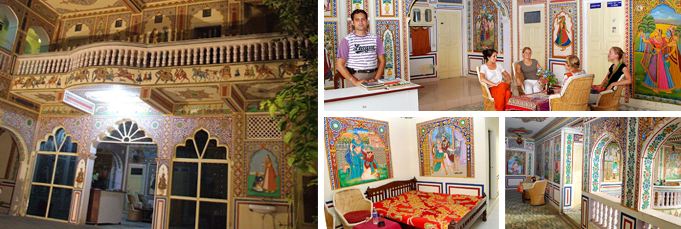
Shekhawati Haveli or Similar - Mandawa

Ward No.7, Mukundgarh Road, Mandawa, Rajasthan 333704
Hotel Shekhawati A 2 story Luxury Budget Hotel is a 100 Years old Haveli built by Mandawa rulers for theur Musician family now converted in to Hotel. This Haweli is well built and adoroned with the Rajasthani Frescoes prevaling during the last century. Thousand of Tourist came here to see the open air Gallery of Rajasthan.
Most Popular Facilities
- Internet Facility
- Parking & Camping
- In-house Laundary
- Room Service
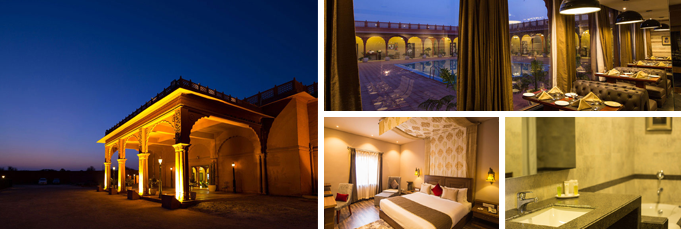
Vesta Bikaner Palace or Similar - Bikaner

10th Mile Stone, Jaipur-Bikaner Highway, Himtasar, Bikaner, Rajasthan 334001
The Vesta Bikaner Palace is an independent design hotel in the city of Bikaner. The hotel is the first design hotel in the state of Rajasthan built as a contemporary masterpiece within a palatial exterior. The architecture of the hotel is built in true heritage Rajasthani fashion with large courtyards, numerous pillars and a genuine haveli feel across the property. The interiors are modern and contemporary with vibrant touches of traditional extravagance built in every corner of the hotel.
Most Popular Facilities
- Swimming Pool
- Free parking
- Free WiFi
- Family rooms
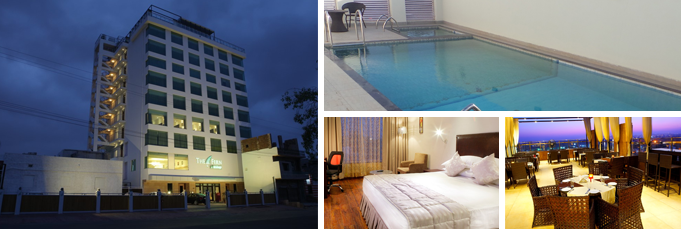
The Fern Residency or Similar - Jodhpur

1B/A, Police Line, Next To Loco Shed Road, Subhash Chowk, Ratananda, Jodhpur, Rajasthan 342001
A Business Hotel in Jodhpur, The Fern Residency is an upscale business hotel with leading environment practices. Stay with us and take the opportunity to save a little for environment while experiencing our 50 rooms and suites, popular dining options and acclaimed hospitality.
Inspired by our Rajput heritage, the hotel balances traditional motifs and styles with modern design. With an excellent location in the centre of Jodhpur, the hotel is close to the Jodhpur airport, railway station and the best tourist attractions such as Mehrangarh Fort and Umaid Bhawan Palace.
Most Popular Facilities
- Free WiFi
- Free Parking
- Smoking & Non Smoking rooms
- Multi-cuisine restaurant
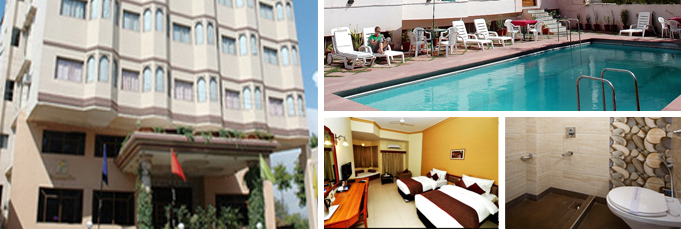
Hotel Vishnupriya or Similar - Udaipur

No.9, Garden Road, Near Gulab Bagh, Udaipur, Rajasthan 313001
Our attraction to win your heart! Whether you are a tourist, a leisure traveler or pilgrim your visit to India is not complete unless you visit the city of Udaipur in the state of Rajasthan. Udaipur is one of the most romantic and lovely lakeside cities in India. Udaipur inherent romance and beauty is marked with beautiful buildings and palaces. Udaipur is surrounded by hills and mountains, and set on the edge of three lakes, Udaipur is adorned with white marble. The narrow streets are lined with coloured stalls, gardens, temples and beautiful palaces.
Most Popular Facilities
- Swimming Pool
- Wi-Fi Connectivity
- Spa & Massage Center
- Indoor Games
- Business Center
- Travel Desk
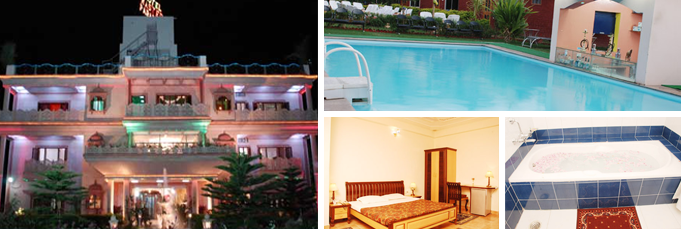
Hotel Master Paradise or Similar - Pushkar

Master Colony, Panch Kund Road, Pushkar, Rajasthan 305022
Hotel Master Paradise is tastefully designed and decorated with antique and modern furniture. The hotel offers 2 Suites, 38 Super Deluxe Rooms, 13 Deluxe Rooms and 9 Cottages. It offers a memorable peaceful and comfortable stay to guests visiting Pushkar.
Most Popular Facilities
- Swimming pool
- Wi-Fi in hotel lobby
- Restaurant
- Room Service
- Mini Bar
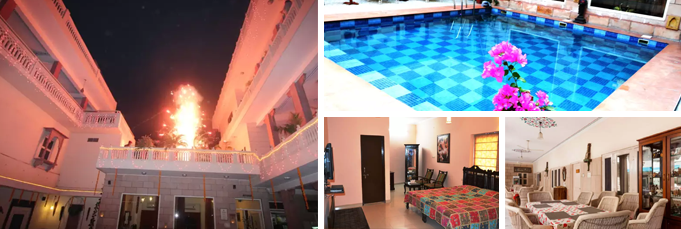
Suryaa Villa or Similar - Jaipur

C-2, Peelwa Garden, Anand Puri, Near NIMS, Moti Doongri Road, Jaipur, Rajasthan 302004
Conveniently located in the Jaipur City Centre, Suryaa Villa, Jaipur, is bordered by numerous historic attractions which are a resplendent reminder of the royal heritage that respired within the walls of the Pink City. We are amongst the finest heritage home hotels in Jaipur which have opened their doors to render the precise sense of redefined luxury to guests.
Most Popular Facilities
- Swimming Pool
- Family rooms
- Restaurant
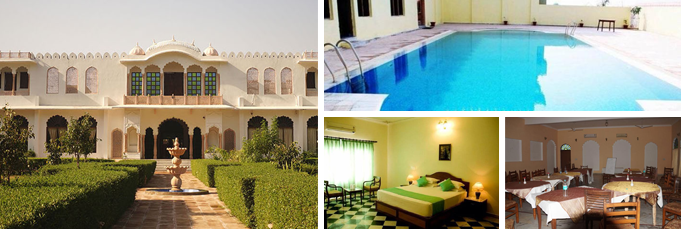
Hotel Surya Vilas Palace or Similar - Bharatpur

NH-11, District - Bharatpur Rajasthan 321001
Hotel Surya Vilas is a family run hotel spanning 42 neat and grand rooms eloquently designed incorporating legacy of Mughlai architecture. Our Deluxe, Executive and Suite accommodation options are equipped with all modern facilities like minibar, Ayurvedic Massage, Sauna Baths, etc. Offering a Swimming Pool with expansive Conference Room and plethora of up-to-date amenities like Satellite television, direct dialing service, cultural and entertainment events etc, we make sure that you come back for more at our Hotel, one of the best Hotels in Bharatpur.
Most Popular Facilities
- Wifi
- Restaurants
- 24-hour room service
- Medical services
- Gardens
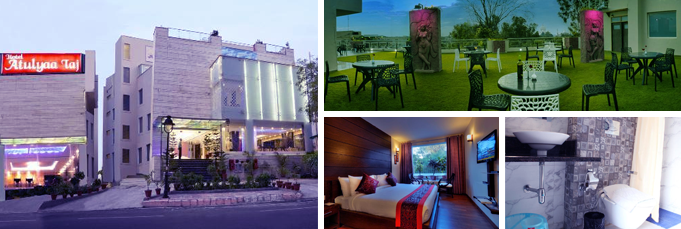
Hotel Atulyaa Taj or Similar - Agra

538, Near Shilp Gram, Taj Mahal Eastern Gate, Agra, Uttar Pradesh 282001
Hotel Atulyaa Taj features a roof top that overlooks the UNESCO World Heritage Site Taj Mahal, located 500 m away. Guests can head to the well-maintained outdoor swimming pool for a refreshing dip. Free WiFi access is available in all areas.
The air-conditioned rooms feature a flat-screen cable TV and dining area. An electric kettle and a minibar are available. The attached bathrooms are equipped with a shower, hairdryer and free toiletries.
Most Popular Facilities
- Swimming pool
- WiFi
- Free parking
- Restaurant
- Room service
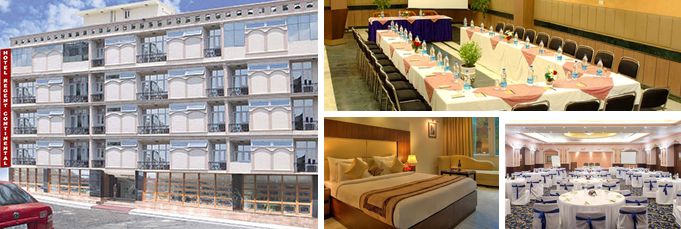
Hotel Regent Continental or Similar - Delhi

4/73, Krishna Market, Saraswati Marg, Karol Bagh, New Delhi, Delhi 110005
It gives us great pleasure to introduce Hotel Regent Continental, Karol Bagh, New Delhi as the best and biggest Hotel in budget category with 3 Star Facilities. We have the necessary expertise and experience to provide service with a difference for all of our valued clients; we combine old word hospitality & charm with the needs of modern trend. Hotel Regent Continental offers world class luxurious Accommodation, Conference Rooms, Business Centre, Multi Cuisine Restaurant, Bar, 24 hrs Coffee Shop.
Most Popular Facilities
- Business Centre
- Conference Rooms
- Multi Cuisine Restaurant
- Bar
- 24 hrs Coffee Shop
Cost of Package does not include
- Personal Expenses such as Laundry, telephone calls, tips. Liquor, joy rides.(which is not mentioned in inclusion list)
- Any other item not specified in “Inclusions”.
- Additional sightseeing or usages of vehicle not mentioned in the itinerary.
Extra Meal Supplement (Optional)
Half Board meal supplement £ 70 Per Person
Full Board meal supplement £ 130 Per Person
You May Also Like

PackAndFly
Book with £ 50 Deposit*PackAndFly
Book with £ 50 Deposit*You will receive a call from 0203 475 0009
Thank you,
Team PackAndFly

Pay Online
All bookings are subject to a booking fee of 1%.
Please Note :
Booking has to be reserved with our Sales Agent prior to making payment through the pay online link. For any reason if we are unable to confirm the same booking, we reserve the right to process refund. After successful payment please drop a email to the concerned agent with the payment details enabling us to process the booking.





















